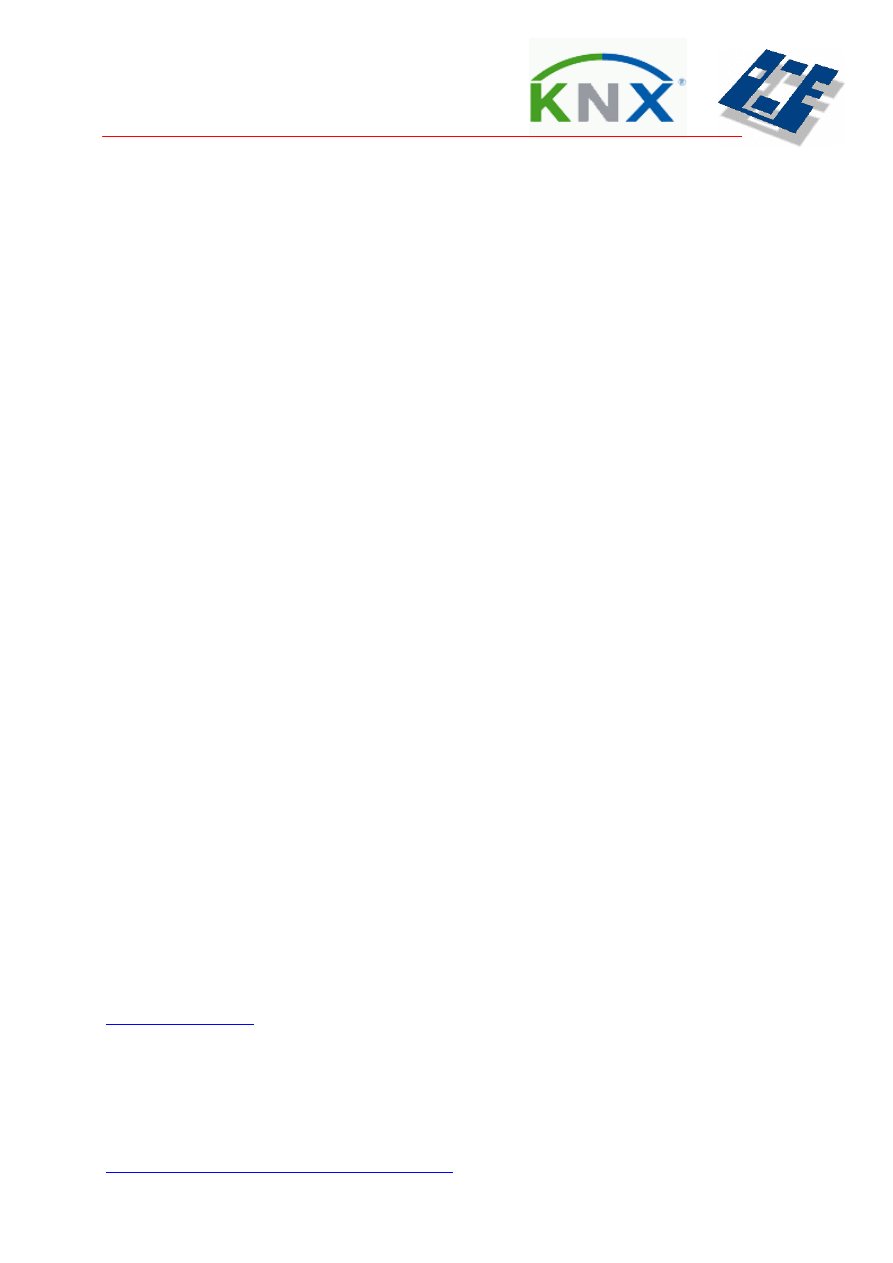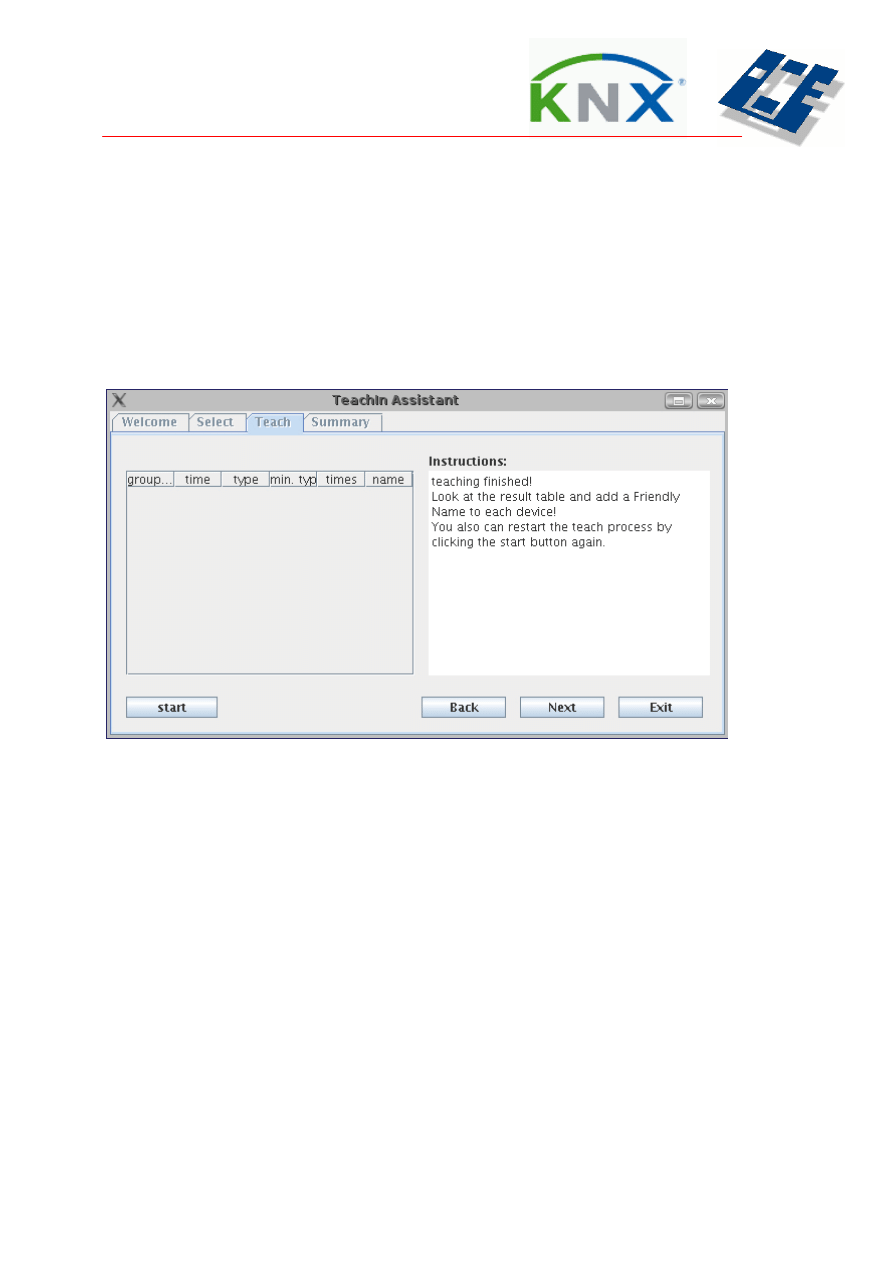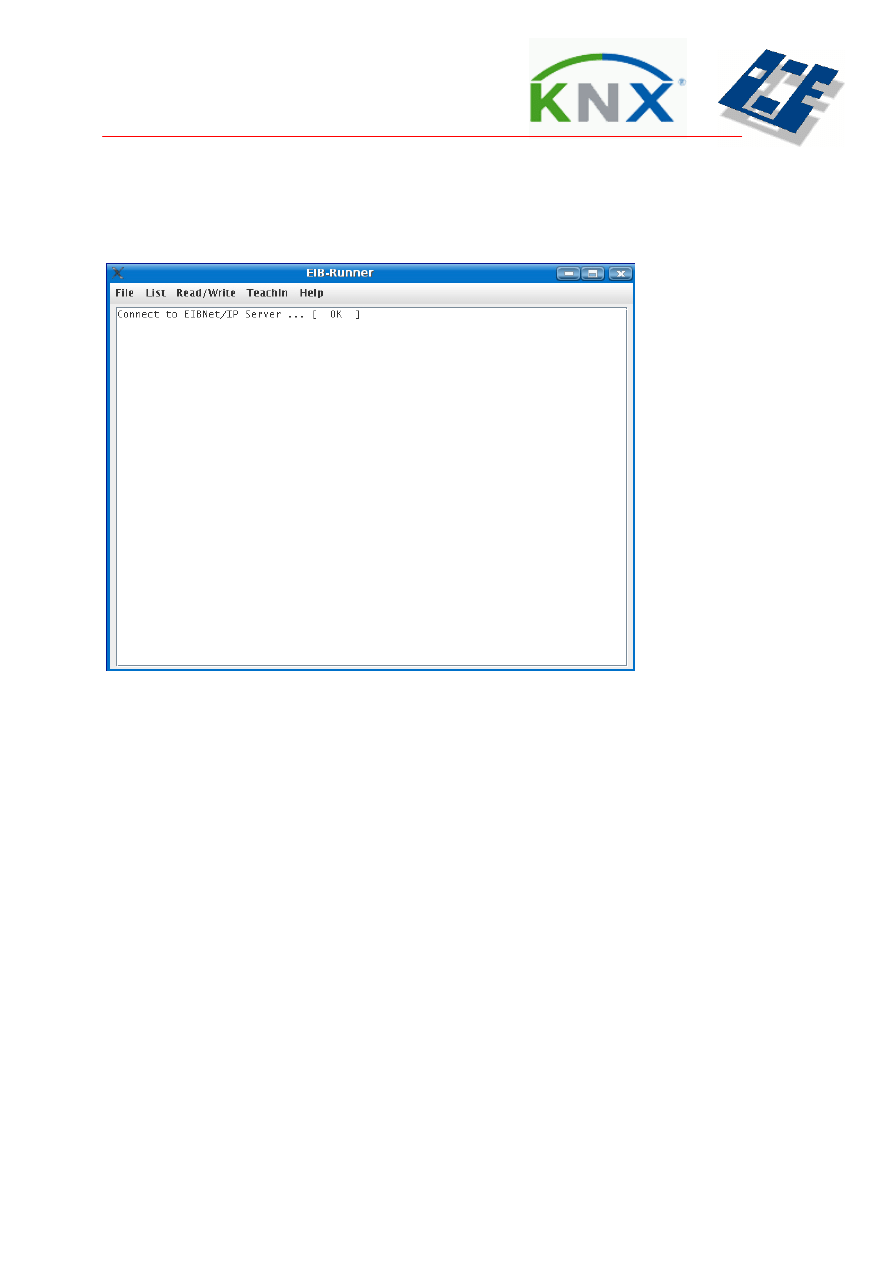
University of Applied Sciences
Deggendorf
Department of Electrical Engineering
KNX@HOME
J S P A N D A J A X B A S E D V I S U A L I Z A T I O N O F B U I L D I N G C O N T R O L S A N D
V I E W S F O R E I B / K N X
Supervisor:
Prof. Dr.-Ing. Andreas Grzemba
Authors:
Richard Wurm
Andreas Reichert
Johannes Bayer
Based on a diploma thesis of Stephan Wuchterl
Contact:
University of Applied Sciences Deggendorf
Centre for innovative communication systems
Edlmairstr. 6+8 / E207
D-94469 Deggendorf
Get more information on:

University of Applied Sciences
Deggendorf
Department of Electrical Engineering
Table of Contents
Decision for HTML, JSP and Struts ............................................................. 6
JSP with the Struts Framework.................................................................. 7
Working modes of the application .............................................................. 7

University of Applied Sciences
Deggendorf
Department of Electrical Engineering
1. Overview
The main goal of the application is to allow the user to control his KNX-BUS installation
with his home desktop computer. This goal is to be achieved by using the KNXLive! from
the
Vienna University of Technology
, which is an operating system that starts directly
from CD. There is also a Teach-In-Module that allows the user to simply add elements
from the KNX-Bus-System to the KNX@Home-Application.
The application should:
- Be able to control a KNX installation of arbitrary size
- Be Controlled and presented web based
- Be flexible and adapted to the users’ needs
- provide full functionality to the user for manual configuration
- be simple
KNX@Home
Image 1: Overview of the application
2. Basic conditions for the live CD
The whole applications (Calimero, Persister, web server) should be integrated into a GNU
Linux Live CD, like Knoppix.
Because of this, the programs have to get by without a hard disc and with the RAM of an
average computer. In fact this is not a big problem, except the database, which requires
the access on a hard disc, USB-stick, SD-card, etc.
Several Live distributions can handle an available empty partition on a data medium to
store the database.
Once the Live CD has started a complete Linux with a graphical user interface like KDE,
the user will be able to use the main application immediately by opening a browser like
Konqueror or Firefox. As home page, the browser will show the welcome screen of the
web interface.
Due to this, it will be very easy for the user to launch our application-bundle, without
installing any programs permanently to his system.

University of Applied Sciences
Deggendorf
Department of Electrical Engineering
3. The Teach-In-Module
The “Teach-In-Module” should handle the easy way of teaching in devices of a building.
Additionally it should get information of available devices through the logged bus-
messages.
It will be made like an installation-routine, completely menu-guided. The teaching of a
switch happens for example by pressing three times a button. The Teach-In-Module will
recognize this action and will show the group address and the possible type (i.e. DPT,
Switch, etc.). The user can choose the adequate type and store it as a data point. Thus,
it will be stored in the database and for now on, it will be available for the web front end.
Image 2: The Teach-In user interface
The action of teaching in a new device can be divided into four steps:
1. The welcome window
When you start the Teach-In process, this screen welcomes the user and
introduces him to the further steps.
2. The select window
In the dialog of the select screen, the user will be asked, which device he would
like to teach in. The user will be able to choose a device out of a list.
3. The teach window
This screen will tell the user, what to do. For example the user has to push five
times the light button, if he wants to teach in the group address of the lamp. The
Teach-In module will watch the bus monitor especially for a group address, which
appears five times in a predetermined period of time. Is a group address with this
attributes found, it will be displayed to the user. Every possible data point will be
listed and the user can choose the right one.
4. The summary window
This window shows the learned data point and will ask the user for affirmation. If
the user confirms, the data point will be stored in the database.

University of Applied Sciences
Deggendorf
Department of Electrical Engineering
4. The Communication
a. Persister
The module – so called „Persister“ – controls the access to the complete database.
Thereby the module offers functions to read and write through Java’s interprocess
communication interface (RMI). Thus Calimero and the web-front-end can access the
persistence-layer.
The Persister consists in the main part of the Hibernate-framework, which provides a
persistence-layer itself. For this, the database access can happen completely object-
oriented.
Persister starts the RMI registry, the RMI server and provides hereupon all the methods,
which are relevant for the persistence.
Image 3: The modules in action
b. Calimero
Calimero establishes the connection to an EIBNet/IP device and acts as an event-handler
for the web application.
The Calimero API was developed at the TU Wien (http://www.tuwien.at/) and students of
the University Of Applied Sciences in Deggendorf have adjusted it for their needs.
Functions:
- establishing a connection to the EIBNet/IP device, connection into both directions,
read and write
- “monitor-mode”, every event on the bus is logged and stored in a database
- event-handler for the web application, i.e. activate switches via web interface,
- remote access to the Teach-In module

University of Applied Sciences
Deggendorf
Department of Electrical Engineering
Through RMI Calimero can access the “Persister”, from where it achieves the database.
The other way round you can control Calimero over the RMI, to switch the light on or off
for example.
Image 3: Screenshot of the adjusted Calimero called “EIB-Runner”
5. The web server
a. Used
Technologies
We use several modern technologies for the application:
- The Apache Tomcat Server as servlet container
- JavaServerPages as the basic concept
- HSQLDB with Hibernate a modern Java database
- The Apache STRUTS MVC-Framework for development and security features
- AJaX as live-communication layer between the client and the server
b. Decision
for
HTML, JSP and Struts
There are numerous different ways to perform a live-communication - for example the
communication could be established by Flash Remote - but working with JSP and Struts
has many advantages: the only thing necessary is a browser that supports HTML, CSS
and JavaScript. You don’t need any special Plug-Ins or even ActiveX components.
A larger independence, maintainability, and sustainability can be provided for by using
standardized components and protocols, which would not be possible if using proprietary
software.
Because the Calimero application from the TU Wien is Java based it is better to also use a
Java based data base (HSQL) Java for the programming of the server.
The MVC framework Struts has been selected to provide security and an easy
maintenance of the application.

University of Applied Sciences
Deggendorf
Department of Electrical Engineering
c.
JSP with the Struts Framework
JSP stands for Java Server Pages and provides an easy and fast programming of web
applications that are independent from servers and platforms. Java code is implemented
into already existing HTML by using JSP standard tags or XML-like tags. This Java code
makes it possible to generate dynamic contents and therefore establish the business logic
independently from the design of the website.
Image 4: The MVC pattern
JSP files are transformed into Java servlets through a JSP compiler and the created
servlet is transformed again by the Java
compiler into byte code all of which is
carried out by the servlet container.
Struts is an open source framework and
the basis for creating web applications
according to the MVC (Model View
Controller) pattern. It uses open standards
and already established design patterns:
JSP, servlets, JavaBeans, resource bundles
and XML files.
Struts connects all these Java technologies
in the background in order to allow
professional development of web applications.
It's common to think of an application as having three main layers: presentation (UI),
domain, and data access. In MVC, the presentation layer is split into controller and view:
- the model contains the data used for the presentation
- the view is responsible for viewing the data from the model
- the controller makes the connection between model and view and receives the
user requests
d.
Working modes of the application
The application consists of two different working modes, the administration mode and the
controlling mode.
In the administration mode you can set the basic options of the system as e.g. user
roles, users, data point types and group addresses.
Additionally within this working mode the physical and the logical structure of the
building (the data points and control elements) is established. For example a ground plan
of the building can be implemented and equipped with KNX symbols.
The second working mode controls the KNX bus and visualizes the current status of the
building.

University of Applied Sciences
Deggendorf
Department of Electrical Engineering
e. Ajax
Ajax is a relatively new technology
based on standard components
(HTML, CSS, JavaScript), that
enables the client (browser) to reload
and change single parts of an HTML
site without having to build up the
whole site again.
The intent is to make web pages feel
more responsive by exchanging small
amounts of data with the server
behind the scenes, so that the entire
web page does not have to be
reloaded each time the user makes a
change. This is meant to increase the
web page's interactivity, speed, and
usability.
In our case the constantly changing
status of the KNX bus in the building
can be displayed almost in real time.
Therefore it is e.g. possible that the use of a switch within the building and its effects are
displayed on the site in an extremely short time, by changing the corresponding symbol.
Image 5: Difference between Ajax and classical web
development
It functions through a timer on the client site (website in the browser) that requests the
current status of the bus from the data base every second.
f. Security
Both, the visualization as well as the control of the KNX bus are very sensitive areas that
mustn’t be accessible openly. That’s why it is necessary to implement a user
authentication as well as a comprehensive user right management into the system. For
that the MVC framework Struts is quite suitable and provides a solid code basis.
Later one can add additional security measures by using SSL encryption with the help of
the Apache web server.
6. Images and resources
Images taken from
- Wikipedia
[Image 4]
- adaptivepath.com [Image 5]
More information:
KNXLive!:
http://www.auto.tuwien.ac.at/Projects/hba/knxlive.html
JSP:
http://java.sun.com/products/jsp/
Struts:
Ajax:
http://en.wikipedia.org/wiki/Ajax_%28programming%29
Document Outline
- KNX@HOME
- JSP AND AJAX BASED VISUALIZATION OF BUILDING CONTROLS AND VIEWS FOR EIB/KNX
- 1. Overview
- 2. Basic conditions for the live CD
- 3. The Teach-In-Module
- 4. The Communication
- 5. The web server
- 6. Images and resources
Wyszukiwarka
Podobne podstrony:
15 ATL 2006 Up scaling KNX for large projects
15 ATL 2006 Up scaling KNX for large projects
puchar swiata 2006 www prezentacje org
Gospodarka płynami kwiecień 2006
Znaki taktyczne i szkice obrona, natarcie,marsz maj 2006
Prowadzenie kliniczne pacjentów z dobrym widzeniem M Koziak 2006
prezentacja cwiczen 2006
Wyklad 09 2006
Wyk 2 WE Polityka monetarna 2006 2
urazy kl piersiowej 04 2006
Wyk 6 Model klasyczny 2006
ADHD 2006
1 zaburzenia krążenia 1 2006 07 III
więcej podobnych podstron